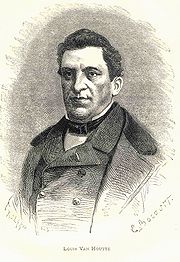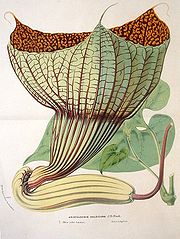
Louis van Houtte
Encyclopedia



Ypres
Ypres is a Belgian municipality located in the Flemish province of West Flanders. The municipality comprises the city of Ypres and the villages of Boezinge, Brielen, Dikkebus, Elverdinge, Hollebeke, Sint-Jan, Vlamertinge, Voormezele, Zillebeke, and Zuidschote...
- 9 May 1876 Ghent
Ghent
Ghent is a city and a municipality located in the Flemish region of Belgium. It is the capital and biggest city of the East Flanders province. The city started as a settlement at the confluence of the Rivers Scheldt and Lys and in the Middle Ages became one of the largest and richest cities of...
) was a Belgian horticulturist who was with the Jardin Botanique de Brussels
National Botanic Garden of Belgium
The National Botanic Garden of Belgium is located in the grounds of Bouchout Castle near the village of Meise, just north of Brussels. It is one of the largest botanical gardens in the world with an extensive collection of living plants in addition to a herbarium of over 3 million specimens...
between 1836 and 1838 and is best-known for the journal Flore des Serres et des Jardins de l'Europe
Flore des Serres et des Jardins de l'Europe
Flore des Serres et des Jardins de l'Europe was one of the finest horticulture journals produced in Europe during the 19th century, spanning 23 volumes and over 2000 coloured plates with French, German and English text...
, produced with Charles Lemaire and M. Scheidweiler , an extensive work boasting more than 2000 coloured plates in 23 volumes published between 1845 and 1883.
Early in his career van Houtte worked in Brussels for the ministry of finance. All his leisure time was spent on botany at the botanical garden and private estates. He was on good terms with men like Parmentier, Édouard Parthon de Von (1788–1877), D’Enghien, and befriended local gardeners.
Van Houtte founded L’Horticulteur Belge (1833–1838), a monthly magazine, in November 1832. He also started a shop selling seeds and garden tools. Botany continued to hold his interest, and the tropical plants flooding into Europe provided a wealth of material for study.
Devastated by the loss of his wife to whom he had been married only a short while, he set off to Brazil
Brazil
Brazil , officially the Federative Republic of Brazil , is the largest country in South America. It is the world's fifth largest country, both by geographical area and by population with over 192 million people...
to collect orchids for Parthon de Von and the Belgian King, while the botanical garden, which was a commercial company by then, would take any new seed he brought back.
He left for Rio de Janeiro
Rio de Janeiro
Rio de Janeiro , commonly referred to simply as Rio, is the capital city of the State of Rio de Janeiro, the second largest city of Brazil, and the third largest metropolitan area and agglomeration in South America, boasting approximately 6.3 million people within the city proper, making it the 6th...
on 5 January 1834, but due to bad weather and stopping over at Maio
Maio, Cape Verde
Maio is the easternmost of the Sotavento islands of Cape Verde. Maio is located south of the islands of Boa Vista and east of Santiago. The island is also known for its large forest, which is unusual for Cape Verde.-Geography:The island covers an area of 269 km²...
in the Cape Verde Islands, only arrived in May 1834. Whilst in Rio, he climbed Corcovado
Corcovado
Corcovado, meaning "hunchback" in Portuguese, is a mountain in central Rio de Janeiro, Brazil. The granite peak is located in the Tijuca Forest, a national park. It is sometimes confused with nearby Sugarloaf Mountain...
and collected in Jurujuba
Jurujuba
Jurujuba is a promontory and one of the 48 administrative districts in which the city of Niterói, Rio de Janeiro in Brazil is divided. It lies in the southern zone of the city, on the coast of the Guanabara Bay....
. Having difficulty in coping with carrying all his equipment, he employed an assistant on a trip to the Organ Mountains.
His next excursion was to Minas Geraes, which he explored for seven months, falling under the spell of the constantly changing scenery between Villa Rica and Ouro Preto
Ouro Preto
-History:Founded at the end of the 17th century, Ouro Preto was originally called Vila Rica, or "rich village," the focal point of the gold rush and Brazil's golden age in the 18th century under Portuguese rule....
. He visited Matto Grosso, De Goyaz, Sao Paulo
São Paulo
São Paulo is the largest city in Brazil, the largest city in the southern hemisphere and South America, and the world's seventh largest city by population. The metropolis is anchor to the São Paulo metropolitan area, ranked as the second-most populous metropolitan area in the Americas and among...
, and Paraná
Paraná (state)
Paraná is one of the states of Brazil, located in the South of the country, bordered on the north by São Paulo state, on the east by the Atlantic Ocean, on the south by Santa Catarina state and the Misiones Province of Argentina, and on the west by Mato Grosso do Sul and the republic of Paraguay,...
.
He had met an English plant collector John Tweedie in Banda Oriental
Banda Oriental
The Banda Oriental del Uruguay was the South American territory east of the Uruguay River and north of the Río de la Plata, coinciding approximately with the modern nation of Uruguay, the Brazilian State of Rio Grande do Sul and some parts of Santa Catarina...
and they made a number of trips together.
When he returned from his 1834-36 expedition to Brazil, van Houtte founded the Ecole d'Horticulture at Ghent
Ghent
Ghent is a city and a municipality located in the Flemish region of Belgium. It is the capital and biggest city of the East Flanders province. The city started as a settlement at the confluence of the Rivers Scheldt and Lys and in the Middle Ages became one of the largest and richest cities of...
and started the horticultural journal Flore des serres et des Jardins de l'Europe, which eventually comprised more than 2 000 coloured plates in 23 volumes published from 1845 to 1883, some volumes being published after his death. Collaborators on the journal were Charles Lemaire and Michael Scheidweiler.
He also established a nursery at Gentbrugge
Gentbrugge
Gentbrugge is one of 25 districts of the city of Ghent, Belgium in the Flemish Region of Belgium. Gentbrugge together with Oud Gentbrugge had been a separate municipality before January 1, 1977, when it fused with Ghent.- Neighborhoods :...
near Ghent with partner Adolf Papeleu. Van Houtte's botanical knowledge, business acumen and facility with languages, led to his commercial success and the office of mayor of Gendbrugge.
At the height of European orchid mania
Orchidelirium
Orchidelirium is the name given to the Victorian era of flower madness when collecting and discovering Orchids reached extraordinarily high levels. Wealthy orchid fanatics of the 19th century sent explorers and collectors to almost every part of the world in search of new varieties of orchids....
in 1845 he despatched plant collectors to the Americas to search for orchids and other exotic plants. Van Houtte produced plants for European conservatories and with the help of Eduard Ortgies
Eduard Ortgies
Karl Eduard Ortgies , was a German horticulturist and nurseryman.His father was a noted plant enthusiast and owned an extensive garden, so that Eduard was encouraged to choose the same career and accordingly began as apprentice at the market garden of Herr Böckmann in Hamburg on 1 May 1844. Here he...
cultivated the first Victoria Lily
Victoria amazonica
Victoria amazonica is a species of flowering plant, the largest of the Nymphaeaceae family of water lilies.-Description:The species has very large leaves, up to 3 m in diameter, that float on the water's surface on a submerged stalk, 7–8 m in length. The species was once called Victoria...
on the Continent. By the 1870s van Houtte's nursery was flourishing, covering 14 hectares and comprising 50 greenhouses. The business was carried on by van Houtte's son, when he died in 1876.
He created the genus Rogiera Rubiaceae
Rubiaceae
The Rubiaceae is a family of flowering plants, variously called the coffee family, madder family, or bedstraw family. The group contains many commonly known plants, including the economically important coffee , quinine , and gambier , and the horticulturally valuable madder , west indian jasmine ,...
to honour his friend Charles Rogier
Charles Rogier
Charles Latour Rogier was a Belgian liberal statesman and a leader in the Belgian Revolution of 1830. He became Prime Minister of Belgium on two separate occasions: from 1847 to 1852, and again from 1857 to 1868....
with whom he had fought in the Belgian Revolution
Belgian Revolution
The Belgian Revolution was the conflict which led to the secession of the Southern provinces from the United Kingdom of the Netherlands and established an independent Kingdom of Belgium....
of 1830. This botanist is denoted by the author abbreviation Van Houtte when citing
Author citation (botany)
In botanical nomenclature, author citation refers to citing the person who validly published a botanical name, i.e. who first published the name while fulfilling the formal requirements as specified by the International Code of Botanical Nomenclature...
a botanical name
Botanical name
A botanical name is a formal scientific name conforming to the International Code of Botanical Nomenclature and, if it concerns a plant cultigen, the additional cultivar and/or Group epithets must conform to the International Code of Nomenclature for Cultivated Plants...
.
Titles and honors
- Member of the Royal Botanic Society of Belgium
- Member of the Royal Agricultural and Botanical Society of Ghent
- Commander of the Order of Charles III (Spain)
- Knight of the Royal Order of Leopold (Belgium)
- Knight of the Imperial Order of Saint Anne (Russia)
- Knight of the Imperial Order of the RoseOrder of the RoseThe Imperial Order of the Rose is an Brazilian order of chivalry, instituted by Emperor Pedro I of Brazil on 17 October 1829 to commemorate his marriage to Amélie of Leuchtenberg....
(Brazil)

